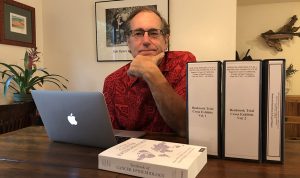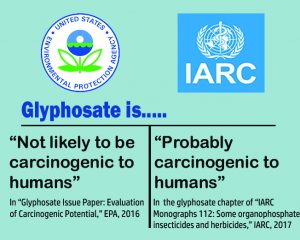My analysis comparing the evaluation of glyphosate, and glyphosate-based herbicide (GBH) genotoxicity by two key agencies — the U.S. EPA and IARC — was published January 15, 2019 in the peer-reviewed journal Environmental Sciences Europe. The full text of the open-access paper “How did the US EPA and IARC reach diametrically opposed conclusions on the genotoxicity of glyphosate-based herbicides?” and a full suite of additional information and resources are available here.
Since September 2017, I have been serving as an expert witness in litigation involving the contribution of Roundup (a glyphosate-based herbicide) to non-Hodgkin lymphoma. I testified on behalf of Lee (Dewayne) Johnson during his trial in San Francisco in the summer of 2018. For some reflections on that experience, see my post-trial blog.
I have produced two versions of an ~200 page expert report setting forth my opinions in the cases for which I have been designated as an expert. Lawyers representing Monsanto in these cases have exercised their right to depose me, and other plaintiff experts.

The purpose of depositions in civil litigation is to compel experts to fully explain their qualifications to address issues before the court, their findings and opinions as stated in expert reports, and the analytical foundation for such findings and opinions. Thus far, I have been deposed five times over seven days, and produced more than 50 hours of sworn, videographed testimony.
Probably close to 10 of the ~50 hours of my depositions, starting with my first two-day deposition in Orange, Virginia on February 8-9, 2018, has focused on my opinions and analysis of the EPA’s and IARC’s assessment of the genotoxicity of glyphosate and glyphosate-based herbicides (GBHs).
I spent considerable time in 2018 studying in detail the process and substance of the EPA and IARC genotoxicity assessments, with the goal of sharpening my understanding of why EPA and IARC reached such different conclusions.
I also wanted to understand more deeply the consequences of the different conclusions reached by EPA and IARC on the genotoxicity of GBHs, and in particular, how the EPA and IARC judgments impacted EPA’s and IARC’s classification of the carcinogenicity of glyphosate and GBHs (see graphic — EPA “not likely to be carcinogenic to humans”; IARC “probably carcinogenic to humans”).

My research on the EPA’s and IARC’s review of the genotoxicity data available on glyphosate technical (nearly “pure” glyphosate active ingredient), formulated GBHs, and glyphosate’s principle metabolite AMPA (aminomethylphosphonic acid) sharpened my understanding of why the EPA and IARC reached seemingly contradictory conclusions.
My research also strengthened an opinion I expressed early in the case — that the EPA’s judgement that glyphosate poses no genotoxic risk to humans was an essential pillar on which the agency’s glyphosate cancer classification was supported.
Had EPA acknowledged that GBHs pose some genotox risk, I opined that the EPA would not have been able to classify glyphosate and GBHs as “not likely to be carcinogenic to humans” under the agency’s cancer evaluation guidelines.
A key December 14, 2015 EPA document reinforced my opinion.
Aware of the international controversy triggered by the conflicting EPA and IARC classifications of glyphosate and GBH carcinogenicity, the EPA Office of the Administrator asked the agency’s Office of Research and Development (ORD) to review and contrast the scientific justifications for the respective cancer classification decisions made by the EPA’s Office of Pesticide Programs (OPP) and IARC.
The ORD memo explains that the OPP review of glyphosate carcinogenicity did not include a “thorough examination of the mutagenic potential of glyphosate…” It goes on to state:
“…if there is evidence of mutagenic potential or if a mutagenic potential has not been adequately ruled out, then characterization of glyphosate as ‘not likely to be carcinogenic’ could be problematic for this reason alone, given the lack of a high-quality negative epidemiological study.”

When ORD wrote this passage, they of course knew that the IARC Working Group had concluded that there is “strong evidence” that glyphosate and GBHs are mutagenic through at least two mechanisms of action known to be associated with proven human carcinogens (DNA damage and oxidative stress). According, in the above passage, the ORD undercut OPP’s classification decision without directly saying so.
Regulators around the world have followed EPA’s lead in its evaluation of glyphosate/GBH genotoxicity and carcinogenicity. Their determinations that glyphosate and GBHs likely do not pose general population cancer risks, under expected levels of exposure, are grounded on the absence of mutagenic/genotoxic potential.
Hopefully this paper will help regulators, risk assessment scientists, and concerned citizens understand why the EPA and IARC reached divergent judgements, and which evaluation best reflects current scientific knowledge.
Source:
Charles Benbrook, PhD, “How did the U.S. EPA and IARC reach diametrically opposed conclusions on the genotoxicity of glyphosate-based herbicides?,” Environmental Sciences Europe, January 15, 2019, DOI: 10.1186/s12302-018-0184-7.
EPA, “Glyphosate Issue Paper: Evaluation of Carcinogenic Potential,” 2016.
IARC, “IARC Monographs on the evaluation of carcinogenic risks to humans – Volume 112: Some organophosphate insecticides and herbicides,” 2017.

